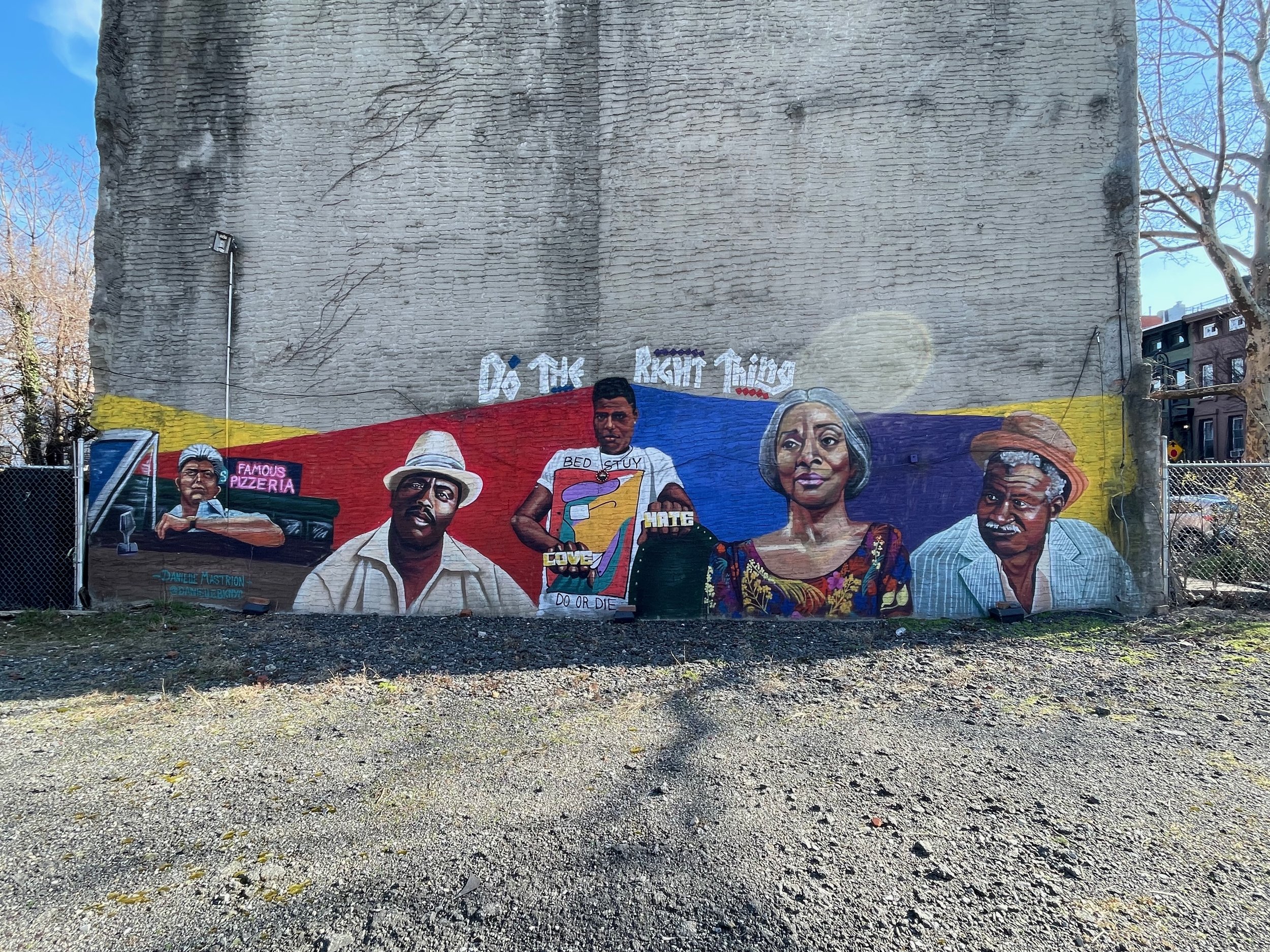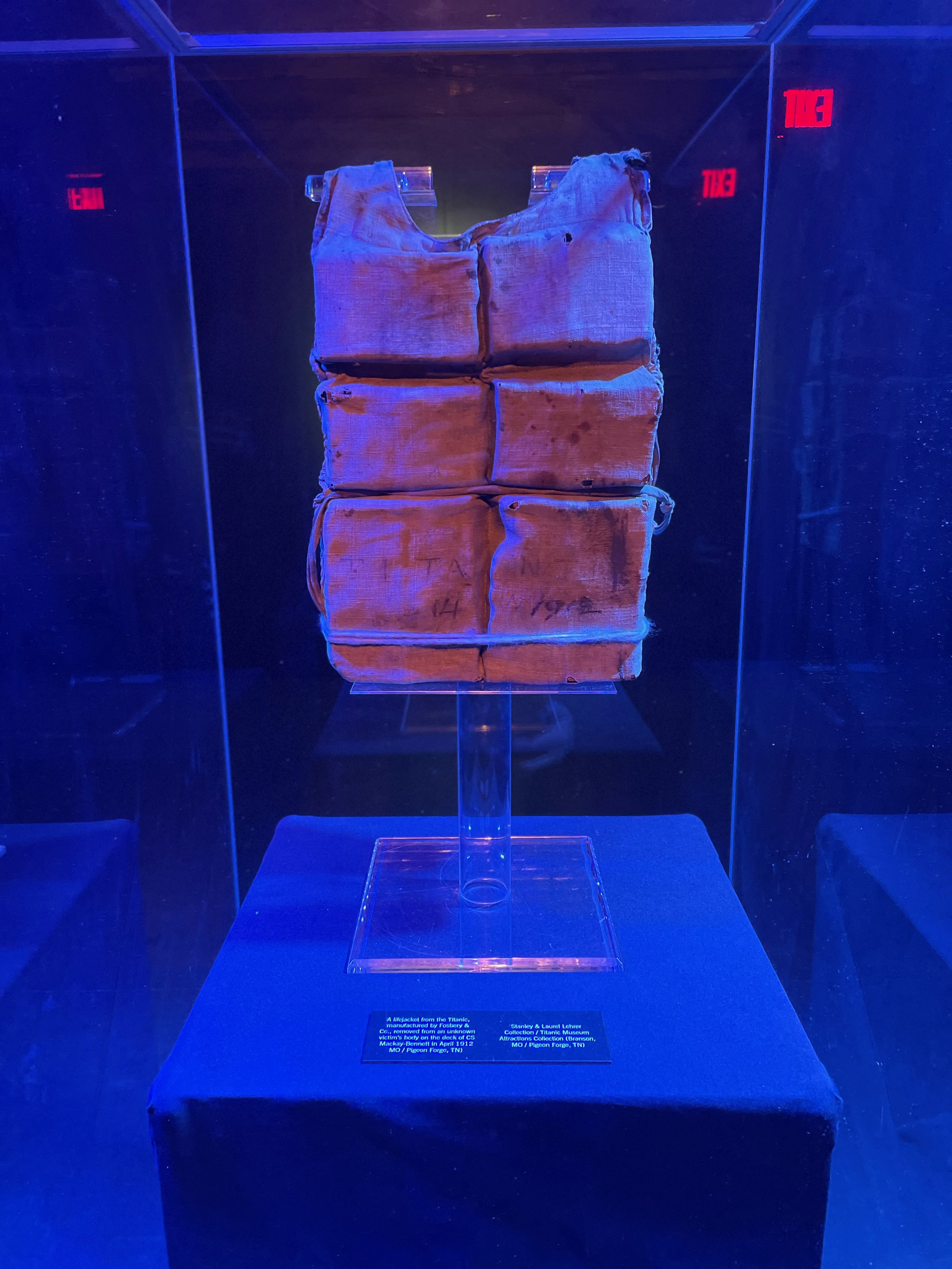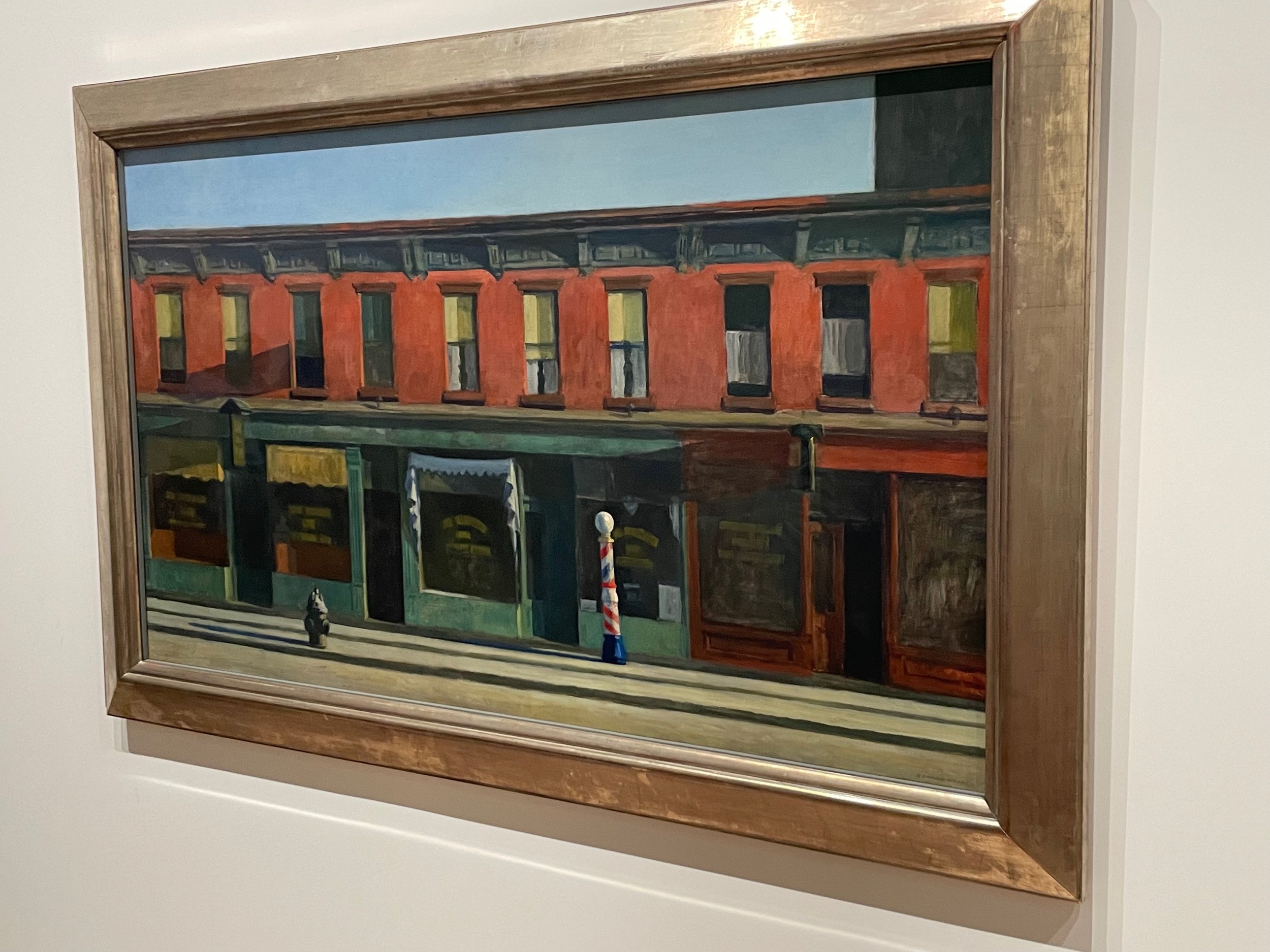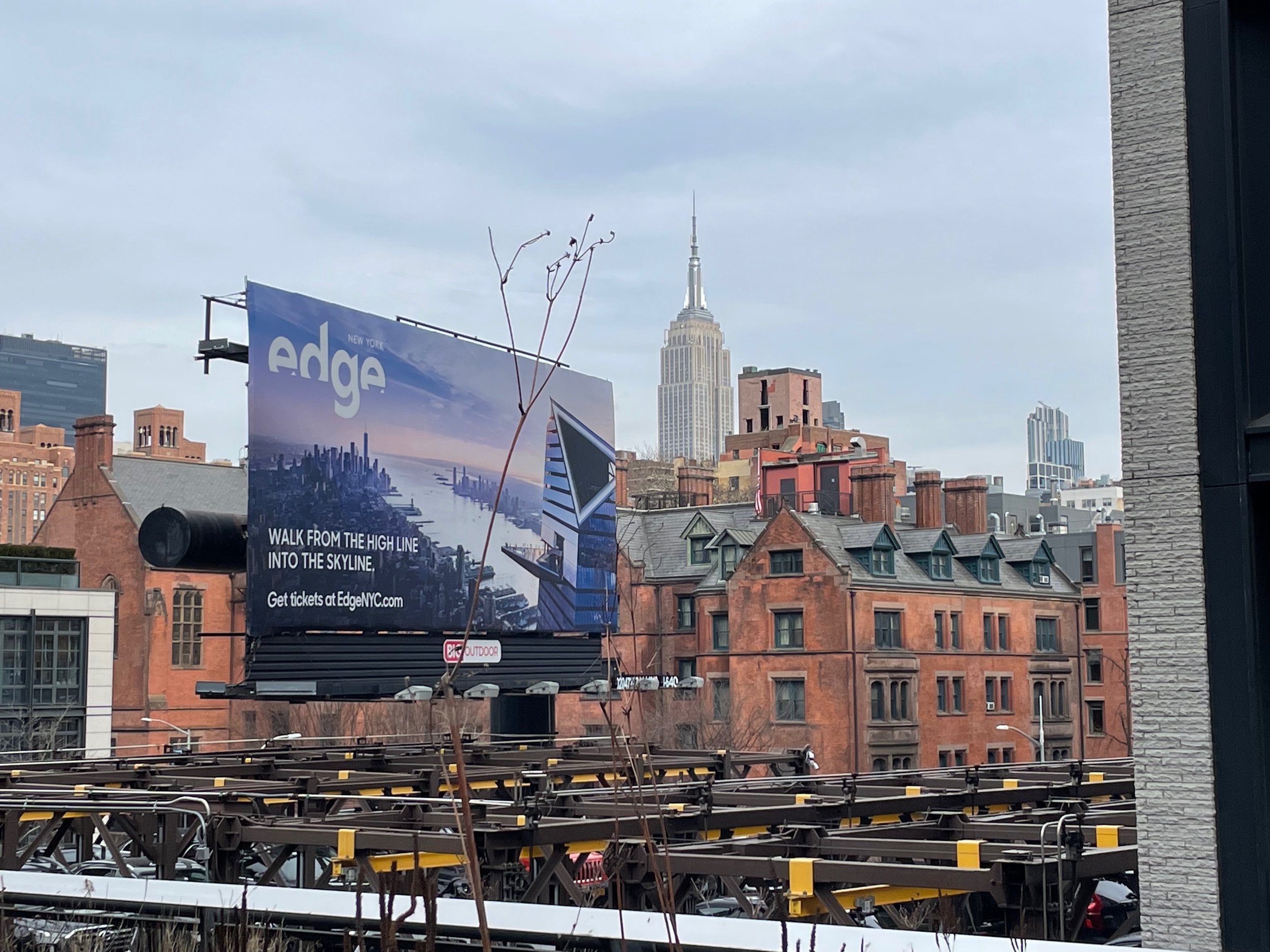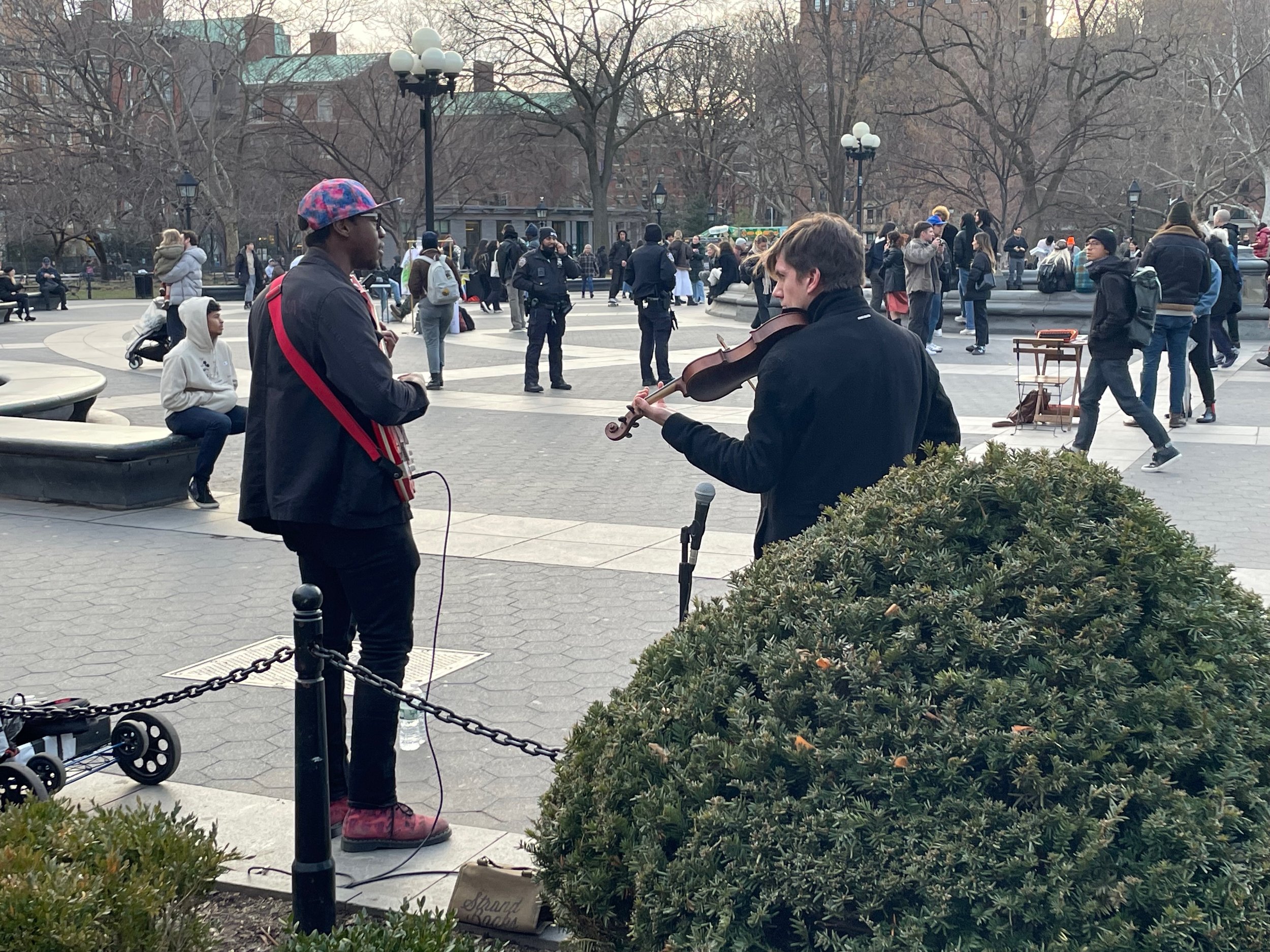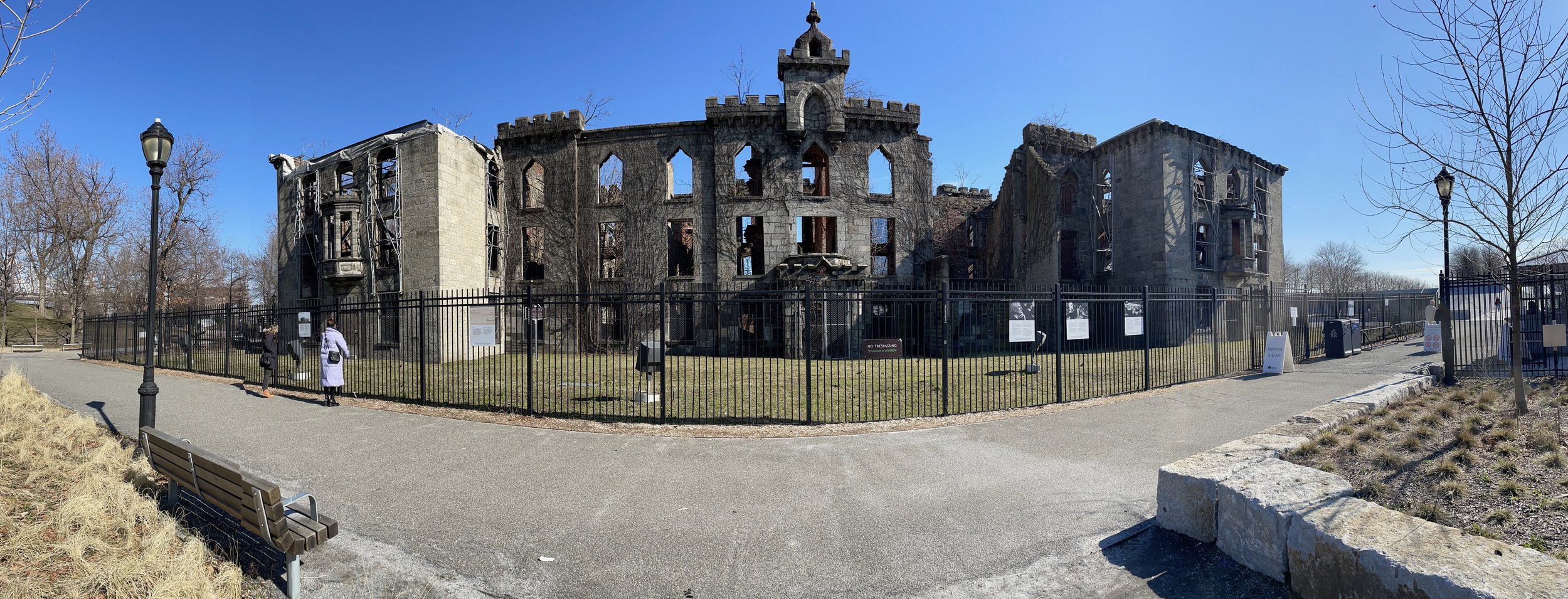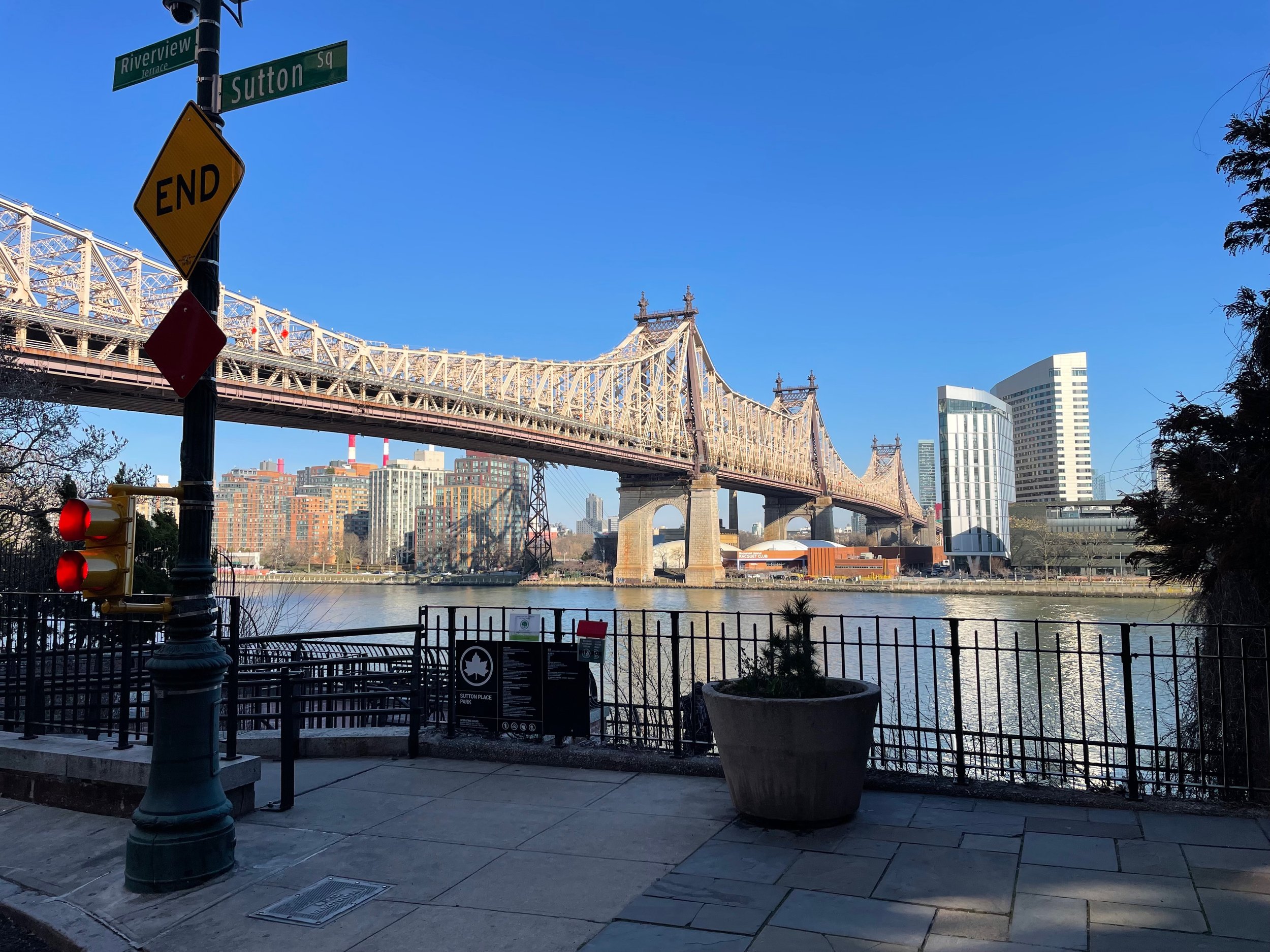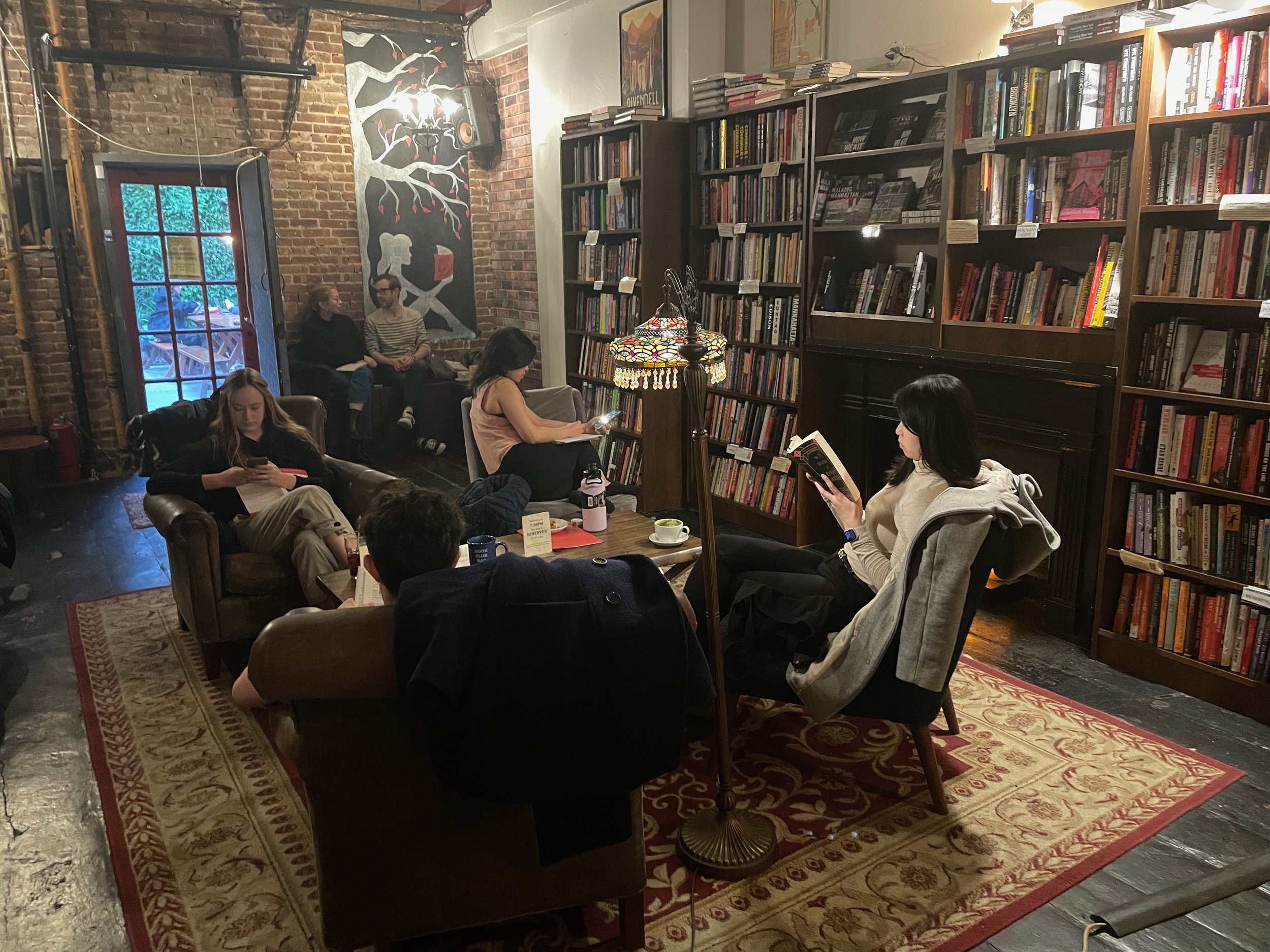Livin’ in New York City Post 17: A Steven Spielberg in an Edward Hopper Exhibit
This mural in Bed-Stuy commemorates the film “Do The Right Thing” and is painted on the site of the Korean Fruit and Vegetable Stand that was built for the movie.
With temperatures averaging in the 50s and the blossoms beginning to appear on the trees, it’s safe to say that we New Yorkers are beginning to see the emergence of spring. And thank God for that. As much as I love the majesty of a winter’s snow and the cozy warmth of thick blankets, socks and sweaters, the endless chilling winds start to drag after a while. Not that that hasn’t stopped me from having a good time. Far from it.
In February, I had the opportunity to see the 1997 film “Titanic” for the first time on the big screen when it was rereleased for its 25th anniversary. Even all these years later, the film is still a marvel of storytelling and effects with the vast majority of models, real-world sets and computer graphics holding up. Like most people who’ve seen “Titanic,” the film awakened a curiosity about the disaster and its rich history. Which is why I went to see the Titanic Exhibition in The West Village.
This exhibition was an eye-opening experience as you were guided throughout this sprawling display of early 20th Century life. Telling the story of The Titanic from its commissioning to the wreck’s 1985 discovery by Robert Ballard, I spent an hour-and-a-half using an audio tour examining all of the artifacts. However, from the get go, you were reminded of the solemn nature of the whole thing when the first exhibit you saw was a life jacket from the night the ship went down. With all of its wear and tear, you quickly understood how you’re not just here to learn about this ship, but also about the 1,500 people who died.
The tour was both fascinating and macabre as you learned about many of the souls who traveled on the ship. Unfortunately, many of the people you learn about were among the dead. Just when you became invested in the lives of these people, you were told that they either drowned or froze to death in the icy North Atlantic waters. But you also were told of the heroism displayed by the crew and passengers of the ship. For instance, First Officer William Murdoch efficiently launched ten of the Titanic’s starboard lifeboats at close to full capacity. He also knew that many of the people on the ship were doomed so he did not follow the order to put only women and children on the boats. Instead, he put women and children on first and also put some men on as well, saving even more lives.
This White Star Line lifejacket was removed from the body of a Titanic victim and now greets you when you visit the Titanic exhibition in New York City.
One of the more innovative parts of the exhibition was where you got to walk through replicas of the first class hallways as you saw the luxurious craftsmanship. When you walked down the halls, the floorboards creaked as if you were on a ship that still needed to be weathered by the traffic of its occupants. There was also a large sheet of ice that you were encouraged to touch, so that you could feel what the iceberg that hit the Titanic would have been like. Seeing the handprints of the visitors that came before, I stuck my whole hand to the sheet of ice. Cold does not begin to describe it. With the exhibition’s stay extended, yet again, in New York, I cannot recommend it enough to both tourists and residents alike.
A week or so after that exhibit, I decided to go to another museum. The Whitney Museum of American Art was having an exhibition of Edward Hopper’s work that was wrapping up on March 5. With my boss Terri and her husband Pat endlessly recommending it to me, I felt I had no choice but to check it out, especially since I’ve always loved the timeless romanticism of Hopper’s work. So, on March 2, I went.
The exhibition was truly remarkable as I saw so many of Hopper’s paintings in the same space. Not only that, I also saw his earlier work including magazine covers, illustrations for the Morse Dry Dock Dial and etchings. What I love about Hopper’s work is that it’s often shown from the point-of-view of an outsider looking in. This is apparent in his most famous work “Nighthawks” which shows patrons of a diner, through the restaurant’s window. Hopper loves his exteriors and, even when his paintings are interiors and even nudes, the painting is a wide shot with the subject's body in full display. Rarely will you see a Hopper close-up picture.
Despite living and working through many transformative times in America, including The Great Depression, The Second World War, the rock and roll boom of the 1950s and the early stages of the 1960s peace movement, Hopper’s work rarely reflects this. Instead, his paintings depict the timeless aspects of Americana.
“Early Sunday Morning:” Steven Spielberg’s second favorite Edward Hopper painting.
But as much as I loved seeing Hopper’s work and its cinematic quality, that was nothing compared to what I saw at the gallery. Or, to be more accurate, who I saw. About ten minutes after I entered the exhibit, I noticed a man, probably in his seventies, wearing a facemask and glasses. However, he has this familiar feeling to him that I couldn’t shake. I kept looking at him instead of the paintings. Then, like a flash, it hit me who I was looking at. It was one of my heroes. A man who inspired me to pursue the artistic life of cinema. It was Steven Spielberg.
Now, I had seen enough interviews and listened to enough director's commentaries to know everything about Steven Spielberg’s mannerisms. Even though he was wearing a mask, I could tell it was him by the eyes. Then, I saw that he was with his wife Kate Capshaw, who many of you might recall for her performance in “Indiana Jones and The Temple of Doom.” As if that wasn’t enough, I saw him turn to the 1930 painting “Early Sunday Morning” and say, “this is my second favorite Hopper painting.” confirming my confirmation.
My excitement was difficult to contain. I had a hard time breathing. I was getting hot to the point where I had to take off my coat and stuff it in my bag. I thought I was going to have a heart attack right then and there and die in a pool of my own sweat. Here I was, looking at the man responsible for some of my most beloved films including “The Fabelmans,” my favorite film of 2022.
However, as tempting as it was to just walk up to him and explode in a mushroom cloud of fandom, I read the room. This man was on a tour with his wife, looking at artwork that inspires him on a quiet Thursday afternoon. I am not going to talk to him because he probably just wants to be left alone. Not that he would be rude to me if I did talk to him, but I wouldn’t want to be responsible for a mob of enthused fans because, as far as I know, I was the only one to recognize him. I was committed to keeping my cool and making sure that no one figured out what I had. I took no photos of him so you’re just going to have to take me at my word.
Since we were touring the exhibit at the same time, I was looking at the same paintings he was. While I wouldn’t use the term “stalker,” since that has a more malicious connotation, I was trying to follow him while not following him. I wanted to give him space and respect but I also wanted to be breathing the same air as him. Perhaps some of his genius would rub off on me. Or I might catch a cold he had. Either way, he would be giving me something.
I never did speak to him which some might view as something to be regretful of. I can just imagine some of you shouting at your screen “He could have given you advice!” But here’s the thing. Spielberg already has given me more than enough advice. It’s called “The Fabelmans.” And “West Side Story.” And “Catch Me If You Can.” And “Schindler’s List.” And “Jaws.” And every other film he’s made. His films have taught me so much about what cinema can accomplish.
If I ever get the chance to talk to Steven Spielberg, I want him to see me as a filmmaker not as a fan. That’s just the way I want it. However, if I were to have spoken to him, this is probably what I would have said.
“Hello, Mr. Spielberg. I don’t want to bother you or take up too much of your time but my name is Parker Otto and I am a tremendous fan of your work. I loved ‘The Fabelmans’ and I’ve seen it seven times in theaters. It was my favorite film of 2022 and it just spoke to me so much. It reminded me of the power that cinema has on filmmakers and their families and how the movies can help us make sense of the world around us. Ever since I was a kid and I saw “Raiders of the Lost Ark,” “Jaws” and “Lincoln,” I have loved your work. I’m a filmmaker myself and your films inspire me so much. I can’t wait to see what you do next and I just want to thank you for all of the joy and inspiration you have imparted to me. I’ll let you get back to your tour.”
Or something along those lines.
Steven Spielberg (left) instructs Gabriel LaBelle on the set of “The Fabelmans,” my favorite film of 2022.
When you think about it, I’m kind of a filmmaker magnet. In the nine months that I’ve lived here, I have seen four of my favorite filmmakers. In August, I saw Spike Lee at a merchandise sale he was having at 40 Acres and a Mule Filmworks in Fort Greene, Brooklyn. I actually got to meet Werner Herzog and have a short conversation with him at the NYC Documentary Film Festival following the premiere of his film “Theatre of Thought” in November. Just two weeks later, I also saw Quentin Tarantino on his book tour for “Cinema Speculation.”
Now I’ve seen Steven Spielberg. Only there was one key difference. This meeting was completely unorchestrated. I knew Spike Lee was going to be at the stoop sale and I knew that Werner Herzog would be at the premiere of his own film. As for Tarantino, I bought a ticket to see him from the cheap seats of The Town Hall. Seeing Spielberg was a simple cosmic, coincidental fluke. Is this a sign? I have no clue. But my desire to make films has intensified and I one day hope to meet him again as a peer. I also released something important as I stood next to Speilberg, just staring at “Early Sunday Morning.” I am taller than Steven Spielberg. I know that in no way makes me a good filmmaker nor does it have any relevance whatsoever, but I think it’s a cool detail to add.
But this meeting did have its conclusion. After about 45 minutes in Spielberg’s presence, I went to a part of the museum where a bunch of photos of old theaters were being projected on the wall. I sat down on a bench to look at them as Spielberg stood behind me. A minute later, when I got up, he was gone. As if he was a figment of my imagination. But I can assure you that he was all too real.
After the encounter of a lifetime, I needed to walk off the adrenaline that was brewing inside of me. Fortunately, the Whitney is right next to the entrance of The High Line, a park built on decommissioned elevated train tracks that runs for a mile-and-a-half. While the greenery wasn’t thriving, it was still an incredible walk that I hope to revisit when the plant life is fully in bloom.
This view of the Empire State Building can be seen while walking along The High Line.
When I was done walking back and forth over the streets, I needed to print something out. So, I went to the library. But not just any library. I went to the Jefferson Market Library which, aside from the iconic Stephen A. Schwartzman Main Branch of the NYC Public Library and its iconic lion statues, is the best library I’ve seen in the city. Housed in a gothic castle that used to be a lookout tour and a courthouse, this place has all of the usual pieces you’d expect in a building that looks like that including spiral staircases and stained glass windows.
As if that wasn’t enough, I still felt the need to explore because, once you unlock that side of yourself, it’s difficult to tame. When I was walking down 6th Avenue, also known as “The Avenue of the Americas,” I spotted a newsstand and bought a paper from there. While the NYC bucket lists of many people involve getting M&Ms from Times Square or seeing the view from the Empire State Building’s observation deck, mine has “go get a copy of the Times from a corner newsstand.”
But I needed a place to read my paper and I was getting hungry. So, I went to Joe’s for a quick slice and then I walked to Washington Square Park to read. The warmer-than-average weather seemed to bring everyone out to play and, as I read, I took many glances at all of the characters around me. If you’ve ever seen Richard Linklater’s excellent film “Slacker,” you’ll know what I’m talking about when I say this. You could make a film just as entertaining as “Slacker,” if not more so, if you just set the whole thing in Washington Square Park and followed the antics of everyone in the vicinity of the Washington Arch.
Everywhere I looked there was someone interesting. Towards one end of the park, there was a woman dancing to classical music. At another end, there was a guitarist and a violinist playing Bob Dylan songs. In between them, there were a few people who had set up card tables and typewriters to compose poetry on the spot for a small fee, of course. And who can forget the skate rats moving about in the empty fountain on their boards, trying to impress their peers without breaking their necks. I wonder where they go when the fountain comes back on in the spring.
This duo entertained the visitors to Washington Square Park with covers of Bob Dylan and other folk/rock classics.
To be honest, March 2 was one of the best days I’ve ever had in New York. After weeks of cold weather and what I perceived to be a sense of hostility from the city, this day reminded me of the beauty New York has to offer. Yes this city can feel like it’s kicking you to the curb and hitting you in the nuts, but it also can pick you up and make you feel like you can accomplish anything. Leave it to Spielberg, abandoned train tracks and modern Bob Dylan covers to bring me to this realization.
Later that week, I was invited to hang out with my friends in Red Hook, a part of Brooklyn south of Dumbo and the naval yards that’s bordered by New York Bay. Everything about this neighborhood felt like a blend of the working class with the hipsters. My friends and I met at this fantastic bar called Sunny’s, just a block or two from the sea. Imagine a bar where singing sea shanties wouldn’t be seen as peculiar. This felt like the kind of place where I could do my best imitation of Robert Shaw’s Quint from “Jaws.” “Cage goes in the water, you go in the water, shark’s in the water. Our shark.”
Whilst having a pint, I took a good look at the place and saw all of these quirky wooden statues that adorned the bar. They were caricatures of Hollywood’s Golden Age stars including the five Marx Brothers, John Wayne, Laurel & Hardy and the modern medical giants Dr. Howard, Dr. Fine and Dr. Howard. In the back was a band playing live music that couldn’t help but get you in the mood for the upcoming Saint Patrick’s Day complete with the fiddle and the mandolin. I thought that Brenden Gleeson and Colin Farrell were going to burst in with the former telling the latter how he just doesn’t like him no more.
But Sunny’s was just the beginning of our sojourn to Red Hook with the rest of the afternoon being dedicated to walking the streets and seeing what this neighborhood had to offer. As we walked down the sidewalk, we saw a nice, personable lady selling pot out of a Winnebago which is just how it ought to be sold as well as a plethora of record shops and thrift stores. If there’s anything that goes together, it’s wearing a pair of used corduroy slacks while listening to Pink Floyd as the edible you bought from the Winnebago kicks in. But I digress.
Following the day spent in Red Hook, a new wave of cold swept over New York which cemented my frustration with winter. Fortunately, a new warm front came to us and I do hope it sticks around for good. With this newfound weather that was perfect for outdoor exploration, I decided to go somewhere that I had never set foot in: Roosevelt Island.
The Roosevelt Island Smallpox Hospital is currently fenced off while a multi-million dollar project is underway to preserve the structure.
Set between Manhattan and Queens in the East River, this narrow spit of land used to be called Welfare Island: a place for the poor, homeless, sick, decrepit and unwanted individuals that just couldn’t fit in the slums of the five boroughs. Not good enough for the city and not dead enough for Hart Island. Since then, the island has gone through a complete makeover with apartments, condominiums and, of course, bars to become a respectable place. But there are still some remnants of Roosevelt Island’s humble origins. One of them is the abandoned smallpox hospital on the island’s southern tip.
Originally built in 1856, with additions at the beginning of the 20th Century, this haunting wreck was originally built for smallpox patients before becoming a nursing school. Since its abandonment in the 1950s, the structure has become a ruin and an icon in its own right, especially when it was preserved by the National Register of Historic Places in 1972.
For most people, especially of my generation, this hospital will always be remembered as the setting for the climax of 2002’s “Spider-Man.” After saving Mary Jane Watson and a bunch of children trapped in a Roosevelt Island tram car, Tobey Maguire’s web-slinger and Willem Dafoe’s Green Goblin plummet into the hospital where they have their climatic battle, resulting in my favorite action sequence of the film. Not just because it’s the hero and the villain duking it out for the final time, but there’s no early 2000s CGI getting in the way because, as much as I love the “Spider-Man” trilogy, the computer effects of the first film are hit-and-miss. In this fight, the punches feel real and the characters are really killing each other. Spider-Man gets his mask blown apart by an explosion and the Green Goblin gets a wall thrown on him. Ultimately, the fight ends with the Goblin’s death after getting impaled by his own glider. But enough of my review/synopsis of “Spider-Man.” What was it like visiting this structure?
Well, it was spooky yet atmospheric and beautiful. Perhaps I felt this way because it was a warm March afternoon with the sun out and in my face. If it was a cold, windy December night at 2:46 in the morning, I probably would be paralyzed with fear. Fortunately, this was a marvelous day and I was just awestruck by the decayed marvel. Fenced off from the public, the hospital is having some work done which was apparent by the scaffolding that adorned parts of the building’s shell. To preserve the ruin for everyone to enjoy (and by everyone I mean “Spider-Man” fans, goths, emos and guys from Butte, Montana in one of the strangest groups ever lumped together), the city is currently working on stabilizing the structure.
Despite its abandonment, there is still life in the place. Along with birds, I saw this ginger cat just laying out in the sun, not giving a damn about anything around it. Joining the cat in this peaceful serenity were several visitors to the FDR Four Freedoms Park that adjoins the hospital. A true testament to how lovely this day was.
But you know what’s incredibly sad? This hospital is still better looking than some of the modern, swank apartment buildings being built nowadays. I swear, I was walking by a new apartment building. It looked like a Rubik’s Cube with smaller Rubik’s Cubes attached to it. Some of these new architects who take the rule “form follows function” so seriously need to be shot, butchered and resurrected just so the process of torturous murder can be replicated again and again.
I’m, of course, kidding but the gothic structure of the Roosevelt Island Smallpox Hospital just gives it such personality. Can you even imagine suggesting to some of these modern architects to put statues on their buildings like the eagles of the Chrysler Building? They’d probably break down and short circuit. In fact, some of these apartment buildings are so ugly that the only way I would go inside one is so I can ride the elevator to the top and jump off.
I even used to hate Louis Sullivan’s guts because of his invention of the cursed maxim “form follows function.” However, upon further revisitation, it’s important to know that he did create some good buildings and even mentored Frank Lloyd Wright. Minimalism doesn’t have to be a bad thing but ugliness is. The modernist style isn’t the problem, it’s ugly buildings. In fact, I wish I could personally hire Paul Giamatti and Joe Pesci to be a duo of city planners who slap anyone who wants to build an ugly building.
After this internal rant which lasted about 45 seconds, I exited Roosevelt Island the fashionable way. I took the Roosevelt tram car that runs alongside the Queensboro Bridge into the island of Manhattan. Once I had made the trip from one island to a somewhat larger island, which is strange to talk about since I myself live on the largest island in the contiguous United States, I found myself on another important journey.
Over 40 years ago, this spot was used as a filming location for the iconic sunrise scene in Woody Allen’s 1979 film “Manhattan.”
As a filmmaker and a lover of movies, I love to go all over the five boroughs looking for locations from my favorite films shot in New York. When I found out that I was getting an apartment in Bed-Stuy, I instantly looked up the address to see how far it was from the shooting location of “Do The Right Thing” only to be elated when I learned it was just five blocks away. I’ve walked up the steps from “Joker” in The Bronx, I’ve eaten sandwiches where Meg Ryan “faked it” in “When Harry Met Sally” and I’ve had a slice at Lenny’s Pizza from “Saturday Night Fever.” Now, I wanted to visit a truly iconic moment from a movie I love. A moment so beautiful and inspiring that it’s the poster for the film. I’m, of course, talking about the small park where Woody Allen and Diane Keaton watched the sun rise behind the Queensboro Bridge in the film “Manhattan.”
When I looked up the shooting location for this scene, the website I was directed to said that it was filmed at Sutton Place Park. After pulling up the park on my Maps app and walking towards it, I quickly realized that this wasn’t the place. It turns out that, as you walk down Sutton Place, every apartment building has a Sutton Place Park next to it. So, I spent the next half hour wandering Sutton Place looking for the precise location when I finally found it. It is one of the best views I’ve ever seen. Not just because of its fame but there’s just an energy that flows from that particular spot. It’s the stuff that makes me fall in love with New York all over again. Cue the George Gershwin music.
While I’ve been to the place where the scene was shot, I haven’t been there at the exact time. One day, I would just love to stay up all night at a nearby 24 hour diner, talking to someone special as we eat scrambled eggs at three in the morning and then just walk to that little park to see the sun emerge from behind that bridge. Here’s to hoping.
Following that nostalgic trip, I ventured down the island to the Lower East Side to have a drink at this bar that I’d heard about on Instagram. Out of all the bars I’ve been to, Book Club is undoubtedly one of the best. What makes it such an excellent place to visit is that it’s not just a place to grab a beer. It’s a bookstore as well with lighting that’s dim enough to be relaxing but not dim enough to make it hard to read. There’s plenty of wooden benches and leather chairs to sit on as you read their inventory while also having your favorite drink.
When I went in and ordered a cider, I was amazed at how calming the atmosphere was. The music wasn’t in your face, you could have a conversation that didn’t require you asking everyone to speak up and it just had all the cozy feelings you could wish for in a literary nook where you can also get booze. Just when I thought that this bar couldn’t be any more of my scene, the speakers began to play George Harrison’s album “All Things Must Pass.” If you are a book lover or are just looking for a bar that isn’t full of an obnoxious aura, you must go to Book Club.
However, sometimes you do need to go to the old fashioned bars when the moment arises. When it’s Saint Patrick’s Day, the moment has arrived. For my first Saint Patrick’s in New York, I knew that I needed to do at least two things: go to an Irish pub and have a drink that’s been dyed green. Fortunately, I had both with my friends at the Playwright Celtic Pub in the Theater District. And what does green cider taste like? Just like regular cider. No surprise there but it did dye my tongue green so there’s that. After enjoying some Irish food and drinks at the Playwright, we made a small crawl to a few different bars before ending the night earlier than most partying like the Irish.
But through all the green booze, street performers and seeing Steven Spielberg in the flesh is New York. Being in this city has given me experiences that just can’t be replicated anywhere else and, as the heat climbs up, I can’t wait to see all the colorful characters that come out. Bring me the street performers, the musicians, the people who think that hacky sack is still cool, frisbee players and people that put shoes on their dogs. Actually, I could do without the lattermost group. Dogs don’t need shoes. That’s why they’ve got paws.
This Lower East Side bar, Book Club, was the kind of relaxing environment that I absolutely loved. There’s nothing like reading Jann Wenner’s memoir “Like a Rolling Stone” while drinking hard cider and listening to George Harrison songs.


